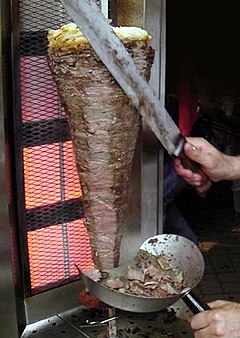 A döner kebab | |
| Course | Snack or main course |
|---|---|
| Place of origin | Ottoman Empire |
| Region or state | Turkey |
| Serving temperature | Hot |
| Main ingredients | Lamb, beef, chicken, or (rarely) pork |
| Variations | İskender, shawarma, gyros, al pastor |
Doner kebab (UK: /ˈdɒnər kɪˈbæb/, US: /ˈdoʊnər kɪˈbɑːb/; Turkish: döner or döner kebap, pronounced [dœˈnæɾ keˈbɑp]), also spelled as döner kebab, is a dish of Turkish origin made of meat cooked on a vertical rotisserie.[1] Seasoned meat stacked in the shape of an inverted cone is turned slowly on the rotisserie, next to a vertical cooking element. The operator uses a knife to slice thin shavings from the outer layer of the meat as it cooks. The vertical rotisserie was invented in the 19th-century Ottoman Empire, and dishes such as the Arab shawarma, Greek gyros, Canadian donair, and Mexican al pastor are derived from this.[2][3][4]
The modern sandwich variant of doner kebab originated and was popularized in 1970s West Berlin by Turkish immigrants.[5][6][7] This was recognized by the Berlin-based Association of Turkish Döner Manufacturers in Europe in 2011.[8]
The sliced meat of a doner kebab may be served on a plate with various accompaniments, stuffed into a pita or other type of bread as a sandwich, or wrapped in a thin flatbread such as lavash or filo, known as a dürüm (literally meaning roll or wrap in Turkish). Kadir Nurman in the early 1970s introduced the sandwich or wrap form, which has become popular around the world as a fast food dish sold by kebab shops, and is often called simply a "kebab".[9] The sandwich generally contains salad or vegetables, which may include tomato; lettuce; cabbage; onion with sumac; fresh or pickled cucumber or chili; and various types of sauces.[10][11]
- ^ Pawsey, Rosa K. (1 January 2002). Case Studies in Food Microbiology for Food Safety and Quality. Royal Society of Chemistry. pp. 109–110. ISBN 9781847550330. Retrieved 15 August 2016 – via Google Books.
- ^ Marks, Gil (17 November 2010). Encyclopedia of Jewish Food. HMH. ISBN 978-0-544-18631-6 – via Google Books.
- ^ Prichep, Deena; Estrin, Daniel (7 May 2015). "Thank the Ottoman Empire for the taco al pastor". PRI. Retrieved 19 March 2017.
- ^ Kremezi, Aglaia (2010). "What's in the Name of a Dish?". In Hosking, Richard (ed.). Food and Language: Proceedings of the Oxford Symposium on Food and Cooking 2009. Vol. 28. Totnes: Prospect Books. pp. 203–204. ISBN 9781903018798. OCLC 624419365.
- ^ "Döner-Streit erreicht Berlin: Wer hats erfunden?" (in German). berlin.de. Retrieved 2 April 2022.
- ^ "Made in Berlin: The Best Doner Kebab on Earth". The Berlin Spectator. 30 June 2021. Retrieved 7 April 2022.
- ^ Cichanowicz, Lily (21 July 2016). "A Brief History Of The Döner Kebab". Culture Trip. Retrieved 7 April 2022.
- ^ "Doner kebab 'inventor' Kadir Nurman dies in Berlin". BBC News. 26 October 2013. Retrieved 7 April 2022.
- ^ "Was The Doener Kebab Invented In Berlin? - Mythbusting Berlin". Berlinexperiences.com. 24 February 2020. Retrieved 1 March 2022.
- ^ "Travel Inspiration: Turkish Döner Kebab in Germany". Kitchn. Retrieved 18 March 2024.
- ^ "Doner Kebab: A Gyros By Any Other Name | Sandwich Tribunal". www.sandwichtribunal.com. 24 November 2015. Retrieved 18 March 2024.